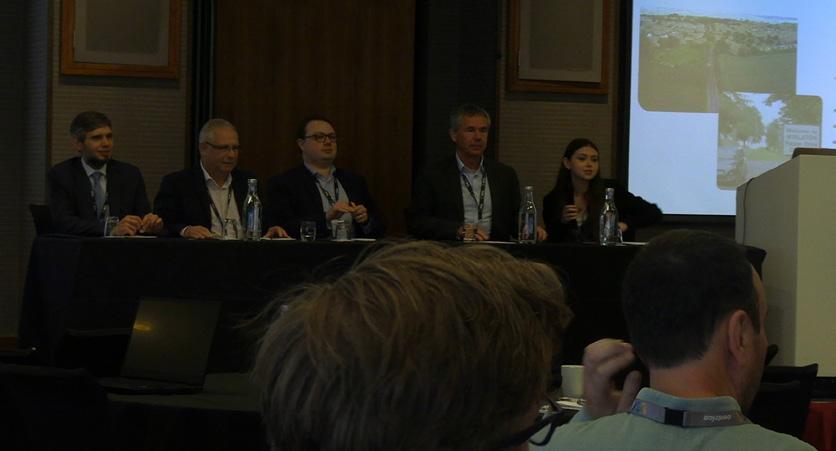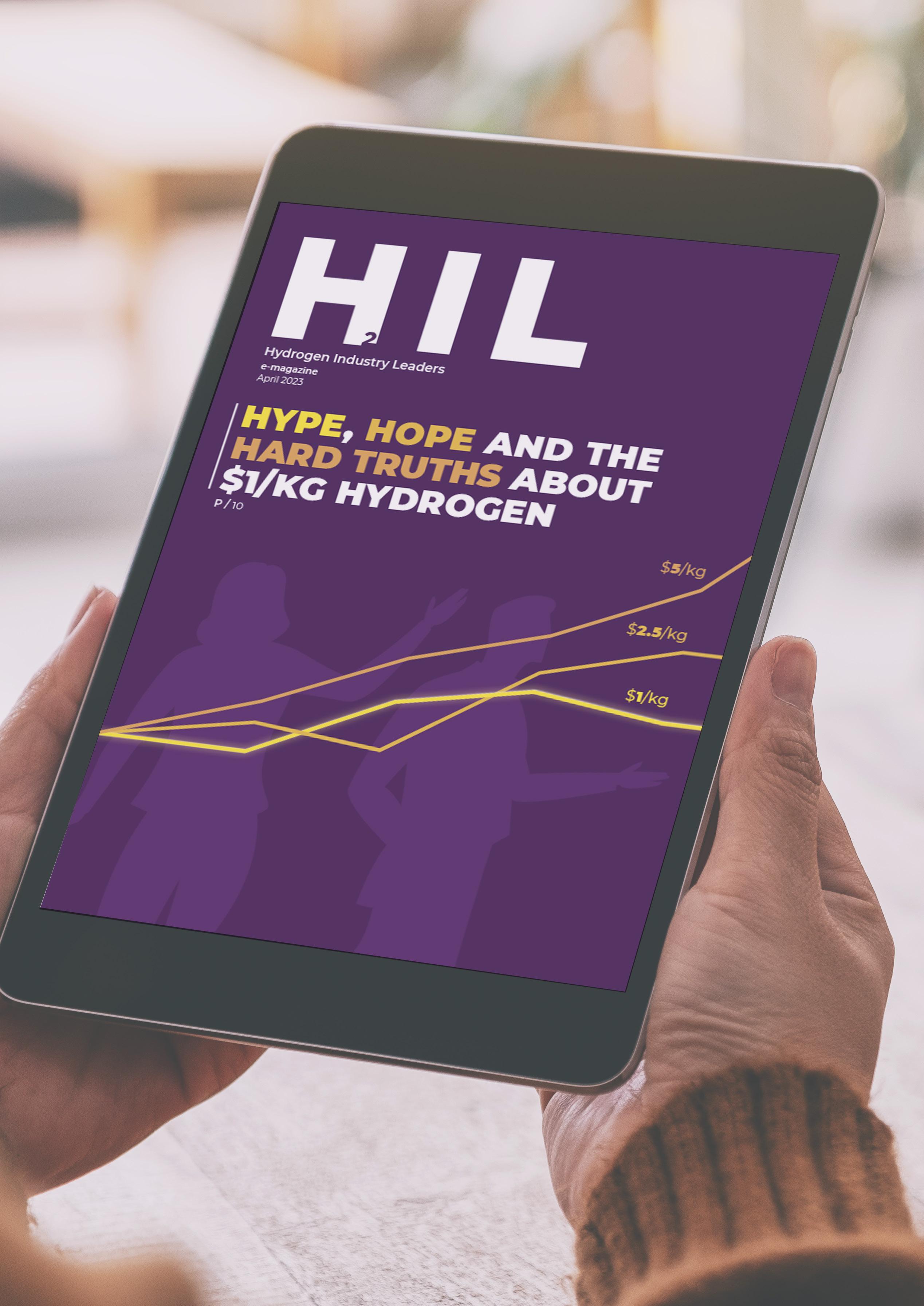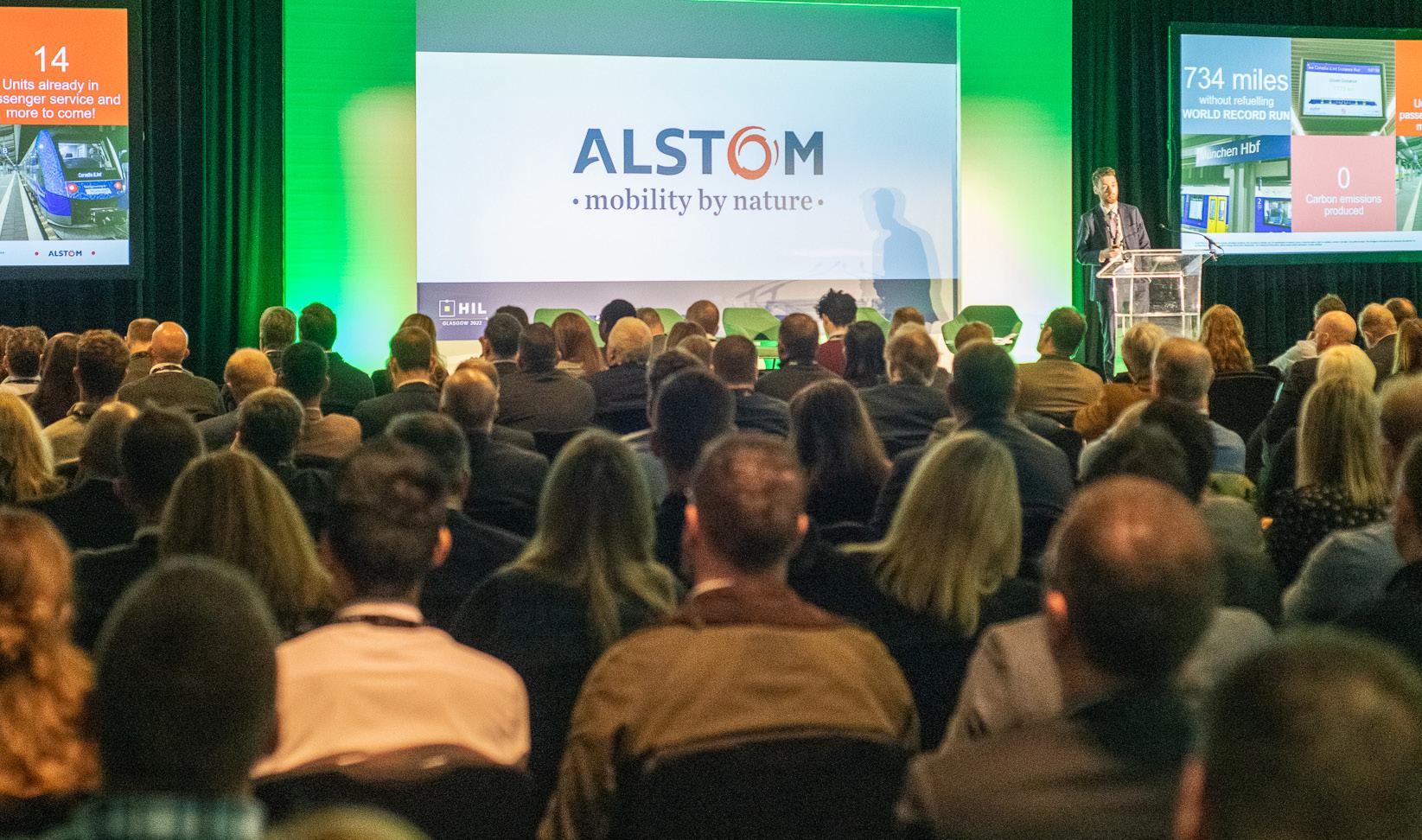CONTENTS
P / 04
Is the EU 2030 Hydrogen Target Achievable?
P / 04
Are the EU’s 2030 Hydrogen Targets Achievable?
P / 06
The Role Translation has on the Hydrogen Economy
P / 08
How to Capture Value in the Emerging Hydrogen Market

P / 10
EEX Launch World First Green Hydrogen Index
P / 12
Developing Renewable Hydrogen Import Routes Into the EU

P / 16
International Projects
P / 10
EEX Launch World First Green Hydrogen Index

P / 14
The Transformational Potential of Hydrogen in Aviation
P / 16
International Projects
P / 18
The North East: Driving the Future of Hydrogen
P / 21
Previous Editions
P / 22
HIL London Next Up
EEX LAUNCH WORLD FIRST GREEN HYDROGEN INDEX


New hydrogen indexes could massively increase investment.

EU TARGETS
IS THE EU 2030 HYDROGEN TARGET ACHIEVABLE?
by Hannah WintleThe EU are aiming to reach a domestic production of green hydrogen of 10 Mt by 2030, as laid out in the REPowerEU plan in May 2022. With seven years left on the clock, reaching these targets will require an unprecedented acceleration in the deployment of electrolysers and renewable electricity capacities, a recent report concluded.
Jointly authored by Zenon Research and Archery Strategy Consulting, the report highlighted that to meet this goal, the EU would need to nearly double its production capacity each year until 2030 in order to meet its target, based on the 0.012 Mt of hydrogen from water electrolysis produced in 2020.
While there is a strong momentum for the increased use of electrolysis – the European Commission has approved €10.6bn worth of public investments into two programmes, with 91% of the projects included using electrolysis – the report asks whether this is enough to achieve the EU’s hydrogen ambitions.
Julien Lamarque Lacoste, Partner at Archery, explained that while reaching this target is a challenge, it isn’t impossible.
He added: “What we have to think of when we think about H2, is that it’s not just compressing and substituting one source of power generation for another one, which is what happened in wind and PV in the beginning of the ramp up.
“Simultaneously, you also have to stimulate the demand in all of the value chain, so it's a faster, more complex ecosystem to build. This is the challenge we have in front of us.” There will need to be a sufficient supply of renewable electricity
It is estimated that to produce 10 Mt of green hydrogen, the EU would need between 500 and 550 TWh of renewable electricity, translating to 160-175 GW of solar power capacity and 120-135 GW of wind power capacity.
With another EC goal to more than double its generation of renewable electricity by 2030, solar capacity must continue to grow by at least 16% per year, and wind capacity growth rate must double.
However, of this additional electricity, up to 36% would be needed to power electrolysers.
Thomas Boigontier, Analyst at Zenon Research and co-author of the report said: “It's a lot of electricity. We need to choose which sector we prioritise because the EU sets rules and targets for the decarbonisation of multiple sectors.
Julien Lamarque Partner Archery“We have to look at this as a system and not just sectors, because it might be possible that we won't have enough renewable electricity for all the things we plan.”
There is a lot to do, but it's feasible of course. We need a systemic approach.
Lacoste
Electrolysis capacity will need to significantly scale up
The electrolyser deployment rate will also need to significantly increase, achieving an average 83% growth rate per year to meet EC targets.
Such a growth is precedented in the energy sector, with solar panel deployment growing by 75% between 2003, and 2011. The two technologies also share common features, such as their standardised and mass-produced nature.
However, electrolyser capacity growth rates would still have to surpass those of solar panels to keep in line with the 10 Mt target, although the report highlights that political will to develop the industry, and the modular nature of the technology could facilitate such a growth.
Furthermore, the Ukraine war has accelerated the phase out of natural gas, and as such, many European countries are supportive of the development of electrolyser technology.
This support has triggered a pipeline of projects under development, but one that would still only produce less than 60 GW by 2030.
Carbon capture could provide the solution to meeting EU targets
In an attempt to offset the aforementioned limitations facing green hydrogen production, the report posits complementing it with other methods of producing low-carbon hydrogen.
Manon de la Motte Saint Pierre, Archery Project Manager, commented: “We tried to study other solutions, complementary solutions, because we think that actually we need to combine different technologies to achieve low-carbon hydrogen production for all our purposes.
“If you look at the available technologies by the end of the decade, only a few of the different hydrogen production methods are mature enough to be available and tangible by the end of the decade.”
Considered the ‘main viable options by 2030’, the report offers possible solutions in steam methane reforming or autothermal reforming combined with carbon capture and storage (NG+CCUS).
Today, announced NG+CCUS projects would represent no more than 600 kt hydrogen by 2030, but it is hoped that with a greater number of projects, a positive industrial dynamic could develop, which would shorten lead times of future CCUS projects and lower costs through economies of scale.
Moreover, financial support is starting to be made available for CCUS solutions, with the EU innovation fund selecting two H2 production + CCUS projects and four CCUS projects for a subsidy in 2021. In 2022, two other calls for tenders were launched, which could provide subsidies to other CCUS projects.

TRANSLATING HYDROGEN
THE ROLE TRANSLATION HAS ON THE HYDROGEN ECONOMY
by Chelsea BaileyNegotiations between countries are difficult enough without having the complexity of definitions of hydrogen in the mix. Language has a huge role in boosting collaboration in the hydrogen economy.
In an emerging sector such as hydrogen, it can be difficult to find the language support needed to move into markets.
Communicating ideas in another language not only requires linguistic skill but a high level of technical understanding to ensure concepts are not misinterpreted.
The Hydrogen Translator works to translate technical and marketing content from German and French into English with accuracy and style so that companies can be confident that their message gets across accurately.
Hydrogen definitions need to be standardised on an international scale
Aston Business School published research in 2021 that investigated 415 small and medium-sized businesses. It revealed that companies making use of language capabilities are 30% more successful in exporting than those who don’t.
Companies can significantly increase their export sales by hiring people with language skills and high cultural intelligence, providing language training to existing staff and investing in professional translation services.
In the hydrogen industry, to ensure that companies are making the best use of this, the language we use to talk about hydrogen is crucial.
Hydrogen Industry Leaders spoke to Nicola Bottrell Hayward, Owner, and Principal Translator at The Hydrogen Translator about the importance of translation for the hydrogen economy.
She explained that when communicating, it is crucial to take into consideration the country and strategy you’re referring to: “You can look at all the different words in English that are used to describe and label hydrogen. For example, green, blue, clean, sustainable, renewable, low-carbon and zero emission. These all mean slightly different things depending where and when you are using it.”
When you are communicating with different countries, every country has their own different ways of describing hydrogen.
Nicola Bottrell Hayward Owner, and Principal Translator The Hydrogen TranslatorEvery country has their own way of describing hydrogen. For example, the UK Hydrogen Strategy differentiates between “electrolytic” and “CCUS-enabled hydrogen” and the German Hydrogen Strategy focuses on “green hydrogen”. France tends to use more vague phrases like “hydrogen with a low carbon footprint”, while the US in its Inflation Reduction Act talks about “clean hydrogen.”
It is essential that the hydrogen industry comes together to standardise definitions on an international scale. This is expressed in a recent report by the International Energy Agency (IEA), which has called the existing hydrogen terminology “impractical”.
Technology is providing the translation industry with a new challenge
One of the challenges that is facing the translation industry is the popular emergence of AI technology.
Nicola highlighted that ChatGPT is showing the potential technology has to create new content to improve efficiency: “There is a lot being written and spoken about ChatGPT and the impact that it might have on different jobs. It is something that the translation industry is looking at.”
ChatGPT has been designed specifically for conversational interactions and tested with human trainers. With its ability to offer opinions on different topics and answer questions, this technology is the most advanced language processing system.
Nicola explained that GPT is unlikely to replace people: “You can use it for translation, but it is prone to error and when mistakes are made, it can be costly for a company. Also, companies need to be proving accurate translations because it is a legal requirement.”
Continuing, she expressed that a lot of effort goes into creating a piece of writing and making shortcuts could end badly: “If you depend on a machine to generate the translation, things can get misconstrued and won’t be communicated properly. This could be embarrassing or end up being offensive.”
Translators can boost collaboration across the hydrogen sector
Nicola revealed that translation is unregulated in the UK and there is no official state authorised translator system in the country, unlike in others: “Stateauthorised translators in other countries are examined by their authorities and are on a certified list. The UK operates in a different way, so that can be particularly problematic.”
She recommended that companies looking for a translation partner should:
1 | Look for individual translators who are members of a recognised professional body. For example, the Institute of Translation and Interpreting.
2 | Look for a translation company which is a member of the above or the Association of Translation Companies, and look for an ISO certification.
3 | Look for a translator or a company with experience in your field. A specialist medical translator will not be the right person to translate your financial reports.
4 | Translators generally (with a few exceptions) translate into their native language. You want to work with someone who is a good writer in the language you want.
Overall, when looking for a translation partner, Nicola explained that it is about: “Looking for people who are particularly specialised in your industry. For example, you wouldn’t get a medical translator to work on your financial reports because you want someone who knows your jargon, and is up to date with the developments in your industry.”
To amplify the hydrogen economy, it is essential that ideas are communicated not only between different companies but different countries. Using language support through a translator will help to show a high level of technical understanding, plus promote collaboration and boost innovation in the industry.
EMERGING MARKET
HOW TO CAPTURE VALUE IN THE EMERGING HYDROGEN MARKET
by Hannah WintleThe growth in production of green hydrogen has the potential to cultivate a value pool worth €500 billion by 2030. At present, however, the immaturity of this emerging market means that the value chain for green hydrogen projects is not yet fully structured.
A recent report by Roland Berger highlights the new business models that are emerging, but estimates that players will only have until the second half of the decade to choose the right one for them, in order to exploit this unique opportunity and shape the industry.
As it stands, green hydrogen is a small market with strong growth perspectives, but will require innovation in terms of how established market players adapt their current business models.
Uwe Weichenhain, Senior Partner at Roland Berger and co-author of the report, highlighted that the key question for developers is to decide which piece of the value chain they take. Also emphasising the need for these industries to formally partner up with technology suppliers, Uwe added: “Since there is still very much a technology risk out there, we see a close link of technology supply and actual project development in these early projects.”
“Looking at the development, we believe that as projects get larger, the old industry structure we've seen in energy infrastructure projects in the green electricity or oil and gas markets, also holds true for the hydrogen market.”
Ultimately, we believe that the technologies and developments will lead to an industry structure that is quite comparable to what we see in energy infrastructure today.
The market will develop in two phases
Hydrogen’s capability to decarbonise sectors that cannot be electrified mean that its uptake is expected to grow massively as governments strive to reach their climate targets.
Therefore, in the five years between 2025 and 2030, the report postulates that the market will grow on the back of government incentives, particularly in the European Union, United States, and Asia.
After 2030, it is thought that the market will become self-sustaining, driven by supply routes between countries with high demand and those with low production costs.
Emmanuel Fages, Senior Partner and coauthor, said: “I would say this is the makeor-break period because until 2030, the projects would be set out. People would start buying hydrogen, you would have return of experience and feedback.”
“When we forecast to around 2030, we are relatively confident afterwards becomes much more hypothetical. We believe that it will be locked in and will continue.”
Emmanuel Fages Senior Partner and Co-authorBusiness models will continue to evolve as the market matures

As hydrogen is a nascent industry with no strongly established business models or structures on the market at present, various market players involved in current projects tend to share risks by operating as part of a consortium.
Due to the lack of any clearly defined roles for the different players, they often act in line with their traditional role. OEMs, for instance, manufacture the equipment required for green hydrogen production projects, and EPC companies provide the necessary engineering, procurement and construction services.
The report predicts, however, that these market players will adapt their business models and thus capture more value as the market matures, as the companies involved will have a greater understanding of the projects’ risks and profit pools.
Three business models are currently competing
In a business model widespread across European companies, project developers, OEMs, or EPC companies are currently acting as pure players. US players, on the other hand, often take the role of technology providers, combining technology (OEM) and installation (EPC) roles. Finally, Asian players largely operate as solution providers, where all roles are covered by a group or conglomerate.
The report acknowledges that at present, it is difficult to pinpoint which business model will be the most profitable. Looking to previous examples demonstrates that value could lie in integration and project development across the whole value chain, such as in the case of photovoltaic cells. However, small, crucial players with a technological advantage could also prove valuable, as they were in the case of electrolysers.
A successful business model ultimately depends on a multitude of factors, including access to renewable energy and type of industrial process used. The report identified four types of green hydrogen production projects: two types of midscale industrial projects differentiated by sharing hydrogen production or producing hydrogen on site, and two types of utility-scale projects, offshore and onshore.
Project developers, solution providers, and technology providers can therefore all benefit from different aspects of the value chain due to the different natures of these hydrogen projects.
Now, it is down to the players to position themselves appropriately so as to secure their role and enjoy a share of the value pool expected to emerge by 2030.
HYDROGEN INDEX
EEX LAUNCH WORLD FIRST GREEN HYDROGEN INDEX
by Floyd MarchWith the launch of the first ‘HYDRIX’ green hydrogen index through EEX, could this be a game-changing aspect of scaling up price discovery in future markets for renewable energy?
Clear price signals are the basis for the market ramp-up and further investments in the hydrogen economy. Up until now this hasn’t been a possibility and it is expected that HYDRIX will go a long way in creating a more secure business case in the future.
Large swathes of the EU will have a balanced scale of production and importing of hydrogen, so a trusted hydrogen index will go a long way in committing to prices in the future.
With vast success with the implementation of indexes in other sectors of the renewable sector, EEX will provide the sector with the foundation for growth. Being the leading electricity and gas exchange has uniquely placed EEX with the helicopter view required to launch an ambitious exchange for hydrogen.
Other exchanges have enhanced confidence in the past
Many big producers and consumers are already part of other EEX exchanges and indexes, and HYDRIX will tie these companies to its platforms and clearing functions in the maturity of hydrogen until 2033 and beyond.
Updating each week, the publicly available transparency platform will be expressed in euros per megawatt-hour (MWh) as the standard metric to follow.
When building the hydrogen product design, over 100 companies working in the field were recruited to help establish the business case for using the model and building confidence in the accuracy.
Having private companies working in conjunction with each other highlights the important role of collaboration when innovating the hydrogen sector. All of this is expected to make the EEX index more successful and scale up the use of the design.
Protections in place against market manipulation
Naturally, indexes are somewhat susceptible to manipulation, but a spokesperson explained: “We have builtin security measures to prevent the index from being manipulated." This will build additional confidence in the product.
The MWh measurement is designed to be on par with other EEX offerings, aiming to establish a connection and intersection to EEX guarantee-of-origin products that validate the renewable attributes of electricity and hydrogen.
Speaking
to Hydrogen Industry
Leaders, Sebastian Himstedt explained: “With HYDRIX, EEX provides transparency to the market. HYDRIX closes a crucial pricing signal gap, building a foundation for a market ramp-up and further investment in the hydrogen economy.”
A market-based index relying on actual trade prices for hydrogen provides a benchmark that can be used for sustainable investment decisions. “We are thus paving the way for the energy industry’s zero-carbon future and demonstrate our leadership in enabling the energy transition” added, Sebastian.
Improving FIDs is a core priority for the global market
This is welcomed news for the hydrogen sector on a global scale as final investment decisions are a little under 10% in the most recent reports. Indexes such as this may build the global framework and evidence base needed to secure more private investment in the future.
Sebastian wrapped up by explaining: “On our mission to build markets together we give an impulse for investments and trading and will further develop our offerings.”
With regards to our power markets, we have a proven track record in supporting the green transition – as you can see for example in our growing volumes in the intraday spot markets, operated by EPEX SPOT in Paris, that has become a cornerstone for the integration of renewables.”
IMPORT ROUTES
DEVELOPING RENEWABLE HYDROGEN IMPORT ROUTES INTO THE EU
by Floyd MarchDeveloping renewable hydrogen import routes into the EU could be a major cornerstone in developing a global hydrogen frameworks. Recent studies by the OIES highlights how existing and future trade pipelines can develop to meet European and global framework.
There is widespread discussion around hydrogen production and use, spanning various platforms and eliciting both bullish and bearish views on the future role in enduse sectors.
Hydrogen is a uniquely positioned sector as there are decarbonisation efforts for existing uses while discourse has grown significantly to explore its potential in new sectors.
The report began by explaining the future of low-carbon hydrogen as an internationally-traded energy commodity. “Prior to 2022, export and import announcements regarding hydrogen did not align with projected supply and demand trends. Given the significant investments required to establish a functional value chain between its endpoints, a stronger signal was necessary to catalyse investment in the export-import domain.”
New EU targets to quadruple imports are the largest import target for decarbonised and renewable hydrogen by 2030 globally. It is likely, for example, that this import target may have stimulated new or existing announcements from export-oriented countries such as Saudi Arabia and the UAE, which have suggested or announced plans to export hydrogen within the next seven years.
Existing feedstock split across sectors
According to recent estimates: “The current global production of hydrogen stands at approximately 100 million metric tonnes. This production constitutes a 60/40 split between pure hydrogen and hydrogen that is mixed with other gases (syngas). Notably, 99% of the hydrogen produced in 2020 was derived from sources with unabated CO2 emissions, where the primary feedstock sources were natural gas and coal (see Figure 1).”
Methane (Pure H2) 43.8%
Methane or Coal (Syngas) 39.6% Coal (Pure H2) 13.4% Chlor-Alkali bi-product 1.9% Methane + CCS (Pure H2) 0.6%
Methane or Coal + CCS (Syngas) 0.4%
Renewable Electrolysis 0.3% Coal / Coke + CCS (Pure H2) 0.1%
When discussing the global landscape of hydrogen and highlighting potential import routes, it is useful to pinpoint the likely areas and regions involved.
Abdurahman Alsulaiman, Author of the report explained: “Geographically, a significant proportion of hydrogen is currently produced in Asia, which accounts for almost half of global production. Meanwhile, Europe and North America combined accounted for roughly onethird of global production in 2020.”
Figure 1: Hydrogen production split by feedstock in 2020 (per cent) Source: EAGHG | 2022An essential aspect of building future trade routes is developing hydrogen price indexes. Addressing this, EEX Bourse launched its Hydrogen Index which reports the trade prices of hydrogen on a weekly level. These market performance reviews help support the roadmap to establishing existing trade routes and discovering potential import routes.
Speaking to Hydrogen Industry Leaders, Abdurahman Alsulaiman explained that: “Enhancing visibility and establishing linkages between supply and demand participants will bolster the future development of the hydrogen value chain, including potential import routes. ” However, increasing market participation will be crucial. “This entails the involvement of competent regulators and standardization bodies from both the supply and demand sides to define and reach a consensus on the rules governing the future trading of hydrogen commodities.”
Potential
trade routes
will use topdown and bottom-up approach
Top-down and bottom-up approaches for the hydrogen market is a widely discussed concept, and is often intertwined with a specific focus on national policy announcements.
When exploring how both approaches can be balanced to ensure the hydrogen economy is being secured on different levels, Abdurahman said: “The interest and motivation behind using different approaches and methodologies heavily depend on the end-benefactors of these analysis tools, such as private or public investors, decision-makers.”
Nevertheless, figuratively speaking, we have to remember that all these analysis tools look at different sides of the same hydrogen economy coin. Therefore, increased visibility and stakeholder dialogue will be key to ensuring a secure hydrogen value chain.
Core recommendations include standardisation
The report concluded with multiple recommendations, although Abdurahman emphasised: “Infrastructure, joint scenario building, technology cooperation, standardization, investment and finance frameworks, market development and trading platforms, education and training, and the creation of coordination hubs.”
Each of these aspects warrants its own dedicated research paper. However, the key first step will be for investors, customers, governments and regulators to work together to establish reasonable confidence in the future revenue stream to enable investors to decide to proceed with hydrogen projects.
We suspect that initial projects are more likely to proceed based on bilateral agreements rather than market pricing, which is likely to come much later in the industry's development.
Abdurahman Alsulaiman
HYDROGEN IN AVIATION

THE TRANSFORMATIONAL POTENTIAL OF HYDROGEN IN AVIATION
by Chelsea BaileyAs the quest for solutions to tackle the climate impact of aviation becomes more urgent, the focus is moving to the role of hydrogen technologies. To determine the potential of hydrogen in aviation, Birmingham Airport has partnered with ZeroAvia for a new refuelling facility.
Aviation accounts for around 2% of global carbon emissions, which is likely to increase as other sectors become more decarbonised. When it comes to technologies that can help decarbonise the aviation sector, hydrogen has been recognised as a solution.
Initial concepts have been created for Birmingham Airport’s refuelling facility in Solihull, created jointly with ZeroAvia. An area of land with access to the airfield and local road network has been earmarked as a suitable location while on-site solar power is being considered as a source of renewable energy to produce the hydrogen.
Analysis by ZeroAvia suggests a 3 MW hydrogen production facility could produce 365 tonnes of hydrogen annually, therefore it could support 1,250 regional flights and 3,000 buses or trucks per annum.
The next step to get to net zero will be hydrogen
Tom Denton, Head of Sustainability at Birmingham Airport explained that to make hydrogen in aviation a reality, collaboration is key: “ZeroAvia is doing work with the actual aircraft, but they can’t operate the aircraft without an airport. We couldn’t do it without them, and they couldn’t do it without us.”
Hydrogen has great potential for aviation with a specific energy-per-unit mass that is three times higher than traditional jet fuel. If it is generated from renewable energy through electrolysis, it emits no carbon emissions, therefore, it will enable renewable energy to potentially power aircraft over long distances.
Tom revealed that there are other alternatives for aviation to reduce its emissions: “One alternative that aviation has is SAF. It is very attractive to airlines because they don’t need any modification of their aircraft, they just drop this fuel right in. However, it is not zero carbon, there is going to be a stage where you’ve exhausted everything you can achieve with SAF.”
We recognise that hydrogen is not the only solution, but it is part of the overall aviation puzzle towards zero carbon.
Tom Denton Head of Sustainability Birmingham AirportPlanning for the required infrastructure needs to begin now to prepare for the arrival of hydrogen-powered aircraft. This airport infrastructure must be in place by 2025 to meet the expected energy demand.
It will be a challenge to see hydrogen-powered flight become a reality due to the current lack of required infrastructure. On this, Tom explained: “The infrastructure that is in place at airports currently is to supply standard jet fuel, this can be utilised by SAF if there is no change to infrastructure. However, hydrogen will need its own pipework, trucks, and a completely new safety case because it hasn’t been built yet.”
Continuing, Tom said that airports must work out how they can have both SAF and hydrogen-powered aircraft running at the same time: “Airports will have to figure out how they can have standard fuel, whether that be SAF or jet fuel aircraft operating in the airport alongside hydrogen-powered aircraft. They need to ensure that this can take place safely.”
Aviation has a 2050 net zero target to reach
When developing infrastructure for aviation, collaboration will be required to ensure that hydrogen aircraft will operate at multiple airports simultaneously. Tom highlighted that the level of investment needed means that airports will not be able to make these infrastructure changes in isolation: “We will need funding and support from the government because we are doing a lot of work right now, but we can’t fund this ourselves.”
Additionally, the aviation industry will need to partner with other industries to secure enough green electricity and hydrogen to be able to shape the future of the hydrogen economy.
We can’t deliver our net zero commitments on our own. We are confident that we can get around two-thirds of the way there as an airport, but the last third is almost a step into the dark without collaboration
Tom Denton Head of Sustainability Birmingham AirportResearch is also providing to be an important area for the future of the hydrogen economy. Tom revealed that Birmingham Airport has been working with universities: “Collaboration is vital, we have done work with Cranfield University and Keele University on research. Unless we get experts from all different fields involved in this, we won’t get the solution that everybody needs.”
If the aviation industry aims to meet its net zero 2050 target, exploring the transformational potential of hydrogen in aviation is crucial, especially as it is estimated that hydrogen has the potential to reduce the industry’s carbon emissions by up to 50%. Through collaboration, hydrogen will provide aviation with a significant solution in taking significant steps towards decarbonisation.

INTERNATIONAL PROJECTS
HYDROGEN PROJECTS FROM AROUND THE WORLD
Denmark

Nordic universities are set to receive green hydrogen production systems from Nilsson Energy to give students practical experience in electrolyser technology.
The Technical University of Denmark, the University of Åland and Mälardalen University are expected to use modular systems to produce hydrogen for research and development with industries such as the transport sector.
Nillson Energy is a system integrator, specialising in the design, construction, and installation of hydrogen-based systems throughout the value chain.
Abdallah Abou-Taouk, Senior Quotation Engineer at Nilsson Energy, highlighted the importance of research into new and improved technologies.
The universities will integrate the systems into their teaching and research activities, giving students and researchers a practical experience of modern electrolyser technology.
Australia

Infinite Green Energy has successfully concluded the front-end engineering and design (FEED) study for its MEG HP1 hydrogen project.
The project, situated in Northam, east of Perth, Australia, is set to generate four tonnes of green hydrogen per day for the medium and heavy transport sectors. Recently, Infinite Green joined forces with Samsung C&T Engineering and Construction Group to welcome Doral Energy Group into the development and construction process of MEG HP1.
Additionally, Samsung C&T has signed an MoU with Infinite Energy to collaborate on another hydrogen project located in Arrowsmith, north of Perth.
The Arrowsmith facility is projected to initially produce 300 tonnes per day of hydrogen, fulfilling the demand in Asia Pacific markets like Japan, South Korea, and Australia.
South Africa
A $1 billion hydrogen fund has been launched between the governments of the Netherlands and Denmark and South Africa to assist the latter country’s decarbonisation efforts.
With plans to export green hydrogen to the European Union, South Africa intends to produce the fuel for use in aviation, green steel, transport and more.
To do so would cost 319 billion rand, or $17.57 billion, according to President Cyril Ramaphosa.
To support the nation’s green hydrogen sector, a joint venture between the Dutch development bank, FMO, and South African insurer Sanlam has dubbed the new fund SA-H2.

Climate Fund Managers, who will run the fund, said: “The SA-H2 Fund initiative will aim to secure US$1 billion in funding, to be raised directly in South Africa or indirectly via other channels.”
Currently, South Africa is the 14th biggest emitter of carbon dioxide globally, due in part to their reliance on a fleet of 15 ageing coal-fired power plants for electricity. As such, European nations are stepping in to aid the country’s transition towards a greener economy to help mitigate climate change.
South Korea

A consortium led by South Korea’s largest steel producer Posco has won a $6.7 billion deal to develop a green hydrogen project in Oman. How can this help Oman become the largest green hydrogen exporter by 2030?
Posco is the development consortium’s largest shareholder with 28 per cent, while Samsung holds 12 per cent equality and is expected to lead on the engineering, procurement and construction of the plant.
A further 24 per cent is owned by two unnamed state-owned Korean power companies, while France’s Engie and Thai state petroleum company PTTEP told a respective 25 per cent and 11 per cent.
Moving to green hydrogen is a huge part of Posco’s strategy to reach net zero by 2050. The company is also considering using hydrogen to decarbonise its power generation, as well as selling it to third parties.
It follows the recent report by the International Energy Agency (IEA) which stated that it expects Oman to be the Middle East’s largest green hydrogen exporter by 2030.
The country is currently allocating around 50,000sq km of land for renewable hydrogen projects in an effort to have at least one million tonnes of annual production capacity by the end of the decade.
NORTH EAST
THE NORTH EAST: DRIVING THE FUTURE OF HYDROGEN
by Chelsea BaileyAfter the second instalment of the HIL 100 Breakfast Hub, this time in Durham, Hydrogen Industry Leaders highlights the main takeaways from the panel discussion and explores the potential of hydrogen in the North East. It brought together industry leaders and experts together to discuss advancements in hydrogen production and research, current collaborations, and the strategic vision to establish the North East as a global leader in the hydrogen economy.
The panel discussion featured Chris Rowell – Head of Net Zero at Tees Valley Combined Authority, Professor Tony Roskilly from Durham University, Professor Dawid Hanak from Teesside University, and Chris Verity – Hydrogen Senior Projects Manager at Northern Gas Networks.
Hydrogen is not the only solution to net zero but it has a huge part to play
The North East is leading the way for hydrogen production, with the Tees Valley producing more than 50% of the UK’s hydrogen. The region has huge ambitions to become the world’s first net zero industrial cluster by 2040.
When asked if the focus on hydrogen meant that the technology is going to be the “saviour” for the UK, Chris Rowell explained that there is no silver bullet to decarbonisation.
He said: “I wouldn’t describe hydrogen as the saviour, there is not just one path when it comes to decarbonisation. It is the same with any energy system, you can’t have just one reliance on one single technology. Hydrogen is part of the mix.”
Chris Verity agreed with Chris Rowell about hydrogen being part of the net zero puzzle: “Hydrogen is not the single solution, but it is going to be a massive part of the picture if we are going to move the quantity of energy that we need to move.”
Hydrogen is being used by Northern Gas Networks as part of an energy product to gather vital evidence about the sustainability of the existing gas network to transport hydrogen in the region.
We must take advantage of different technologies to maximise efficiency
In addition to innovative projects and pilots, the region is accelerating the transition to net zero through extensive research.
This research includes an £11 million project by Durham and Teesside University to identify challenges of production, storage, and distribution of hydrogen and develop the solutions to overcome them.
Professor Dawid Hanak echoed that hydrogen is part of the decarbonisation solution but stated when it comes to deciding what technology to focus on, it is a personal choice.
He said: “Hydrogen is part of the solution; it will help to drive down costs. It is a preference, for example, when it comes to decarbonising heating, hydrogen is a good choice for heat pumps or boilers.
It is all about deciding what is the preferable choice for you and that might be hydrogen.”
While hydrogen shows great promise, it is important to recognise that it may not be the solution for decarbonising every sector. It is about finding the right fit for each context.
By embracing a combination of technologies, we can create a resilient energy ecosystem that maximises efficiency, minimises environmental impact, and accelerates the transition to net zero.
The North East is creating a hub of hydrogen innovation and investment
The UK has set a target of achieving net zero carbon emissions by 2050.
Professor Tony Roskilly explained that hydrogen could be key to seeing this target reached.
He said: “Hydrogen enables us to expand on opportunities to optimise and utilise the renewable energy that we already have, and none of us knows where hydrogen will play the major role.”
This partnership will provide vital lessons on how the fuel can be used in the real world and builds on our strong relationship with Bristol Airport.
The North East’s commitment to developing a hydrogen ecosystem has set the stage for transformational change and is creating a hub of innovation and investment that could revolutionise energy, transportation and more.
Looking forward, Chris Rowell revealed that the region will be looking to advance both blue and green hydrogen: “You will see projects signed off by the government and you’ll see blue and green hydrogen projects looking for government support. You’ll see many projects progress and the emergence of others.”
To see this progression take place, Professor Dawid Hanak revealed that confidence in hydrogen needs to be amplified: “Hopefully, we will see more engagement with industry, we need to come together to talk about hydrogen challenges and solutions.”

The North East is in the perfect position to drive forward hydrogen innovation, both because of its location and its rich industrial history.
From transformative projects to extensive research, the discussions at the HIL 100 Breakfast Hub showcased the progress and breakthroughs happening in the hydrogen industry.


He continued to explain that it isn’t just the UK that is looking towards hydrogen: “At COP26, there were at least 10-12 pavilions that have said that hydrogen is their future and major export resource. The UK has got to get on board with this.”
 Professor Tony Roskilly Durham University
Professor Tony Roskilly Durham University
Building the Hydrogen Economy
LONDON 20 2 3
The Radisson Hotel and Conference Centre, Heathrow
5 July 2023
Making the best use of existing infrastructure, ensuring final investment decisions are improved and building a future-proof hydrogen economy are integral aspects of building a secure hydrogen economy. HIL London will explore how the UK is performing in all these areas and the opportunities in the region.

• How do we build a future-proof hydrogen economy?
• What type of infrastructure will the industry need to develop/retrofit?
• How do we boost the amounts of final investment decisions?
• What are the main bottlenecks, and how do we make the most of these opportunities?
hydrogenindustryleaders.com #









